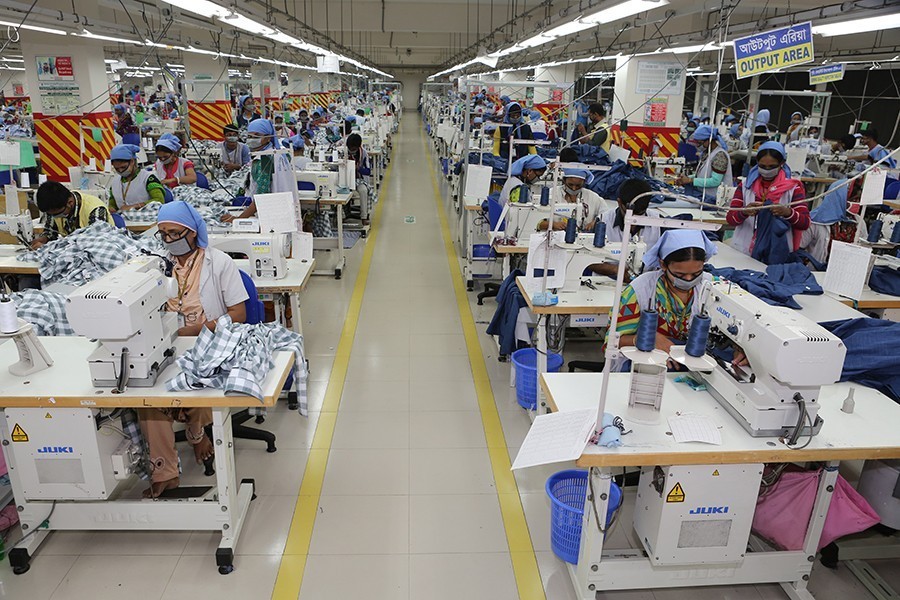
FHM HUMAYAN KABIR AND REZAUL KARIM
Published :
Updated :

Emerging 30 readymade garment items in Bangladesh's export basket raise hope as their shipments continue to grow year on year, amid changing consumer taste, manufacturers and officials have said.
The local apparel producers have recently requested the government to take necessary measures to enhance the shipment to overseas market to earn higher foreign exchange with diversified products, they said.
The Bangladesh Garment Manufacturers and Exporters Association (BGMEA) has written to commerce ministry and other stakeholders to take necessary steps for boosting the export of the 30-odd items.
"After the top 30 major garment export products, the next 30 products could be new hope for the country as their growth is remarkably higher," says a senior Commerce Ministry official.
"We will work on the next 30 products so that those could put a strong footprint on the overseas destinations within few years," he added.
Local apparel manufacturers said Bangladesh's RMG export is heavily dependent on 30 items and some 80 per cent of foreign exchange comes from the total apparel exports. Among those, about 68 per cent of the country's annual export earnings from apparel are still confined to just 10 items.
The 10 most-exported apparel items accounted for $30.94 billion of the country's $45.70-billion earnings last year (2022), BGMEA said, citing the Export Promotion Bureau (EPB) statistics.
According to the apparel association, export earnings from the next 30 apparel and textile items (31-60) beyond the current 30 major ones were US$4.29 billion in the last calendar year-some 59.25-per cent higher than in the previous year.

In the calendar year 2021, the Bangladeshi garment manufacturers made a shipment of $2.69 billion worth of the emerging 30 products. In the year 2020, the figure was $2.08 billion, BGMEA data showed.
Among the emerging products, woven overcoats, car-coats, caps, cloaks and anoraks are on top of the export list as the local manufacturers exported $216.49 million worth of those outfits last year (2022).
The exporters earned $209.72 million from non-cotton woven shirts, $205.66 million from cotton knit blouses, $191 million from cotton woven jackets and blazers, $180.26 million from synthetic knit trousers, $157.77 million from cotton knitted payjamas, and $151 million from cotton knitted coats in 2022.
Bangladesh is the second-largest RMG and textiles exporter to the world's largest market-the United States-as its different basic woven and knit items are getting popular. Denim jeans, T-shirts, shorts, sweaters, women and child wears are the major exports now.
In the early days of Bangladesh's garment industry, the country used to primarily export low-end products such as T-shirts and basic pants. However, over time, the industry has evolved to include higher-end products such as denim and technical textiles.
Bangladesh's cotton knitted T-shirts are the largest item in the apparel-export basket with a 19.55-percent share, followed by cotton woven trousers with 13.0 per cent, cotton woven trousers with 7.95 per cent, cotton knit jersey and pullover with 7.48 per cent as of last calendar year.
The Bangladeshi RMG industry is reliant on export, with the United States and the European Union being the largest markets for its products. Other major markets include Canada, Japan and Australia. The industry has faced with some challenges in recent years, such as the rising costs of labour and the need to improve working conditions and workplace safety.
Research Director at the Centre for Policy Dialogue (CPD) Dr Khandker Golam Moazzem says it's good news that Bangladesh's apparel products are diversifying within the sector.
"However, the local exporters should be coming out from their concentration on cotton-based and knit products and should select those emerging 30 products which will be based on man-made fibre (MMF) and polyester-relevant products," he told the FE about the urgency of diversification of the country's main export industry suiting the changing consumer taste.
Also should they lay emphasis on those products which are being diverted from China, says Dr Moazzem.
Executive President of Bangladesh Knitwear Manufacturers and Exporters Association (BKMEA) Mohammad Hatem said they are working to diversify their products in tune with the export-market needs.
"I hope government will help us to diversify the garment items on the export market," the association leader appeals for state patronage for latest necessary advances of the apparel industry that fetches the country major quantum of its much-needed foreign exchange.
kabirhumayan10@gmail.com


 For all latest news, follow The Financial Express Google News channel.
For all latest news, follow The Financial Express Google News channel.